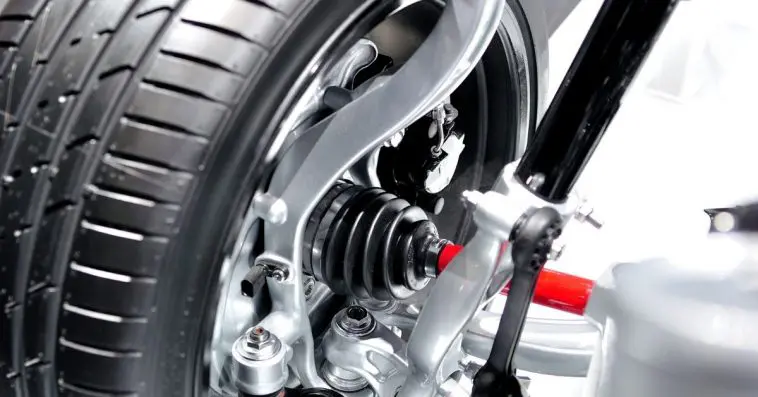If your car wheels start rotating and appear wobbly, there’s no need to be alarmed – it’s perfectly normal. If your wheels appear to be shakier than usual, this is probably because of poor performance from the axles.
‘Axle’ is a term you may have come across several times in the context of cars but are still unsure of what it is exactly.
Well, you’re not alone. In the following sections, we’ll go through the basics of what an axle is and explore the types of axles your car could have.
TABLE OF CONTENTS
What Is An Axle?
Let us begin by answering what exactly an axle is and what function it performs. An axle is nothing but a rod that connects one wheel to the other. But that’s just the gist of it, and the axle does much more than just connect wheels.
It’s a central shaft that spins along with the wheels. An axle controls the power that propels the wheels, which makes it one of the most integral parts of any vehicle.
An axle can turn along with the car wheels as it’s been glued to the latter. In many cases, axles are attached to the vehicle, which allows the wheels to turn around them.
The axle is one of the most powerful components in a car as it has to sustain the weight of the car, its components, and passengers. Along with the axle, you may also have come across the term ‘bearing.’
Bearings are located in the center of the wheels and are known to support the axles. The support they provide plays a huge role in sustaining the weight of your car, especially when you’re accelerating or braking.
The most fascinating aspect of axles is the fact that the power of your car’s engine is transferred to your wheels with their help.
How Many Axles Would You Find In Your Car?
Now, to address our main topic: how many axles does a car have? The axle requirements of a car depend on how big it is and how many tires it has.
Long answer short, one pair of tires requires one axle. So, a car having four wheels typically uses two axles. Some vehicles have even three or more axles, but since most vehicles have only two, these are the ones we’ll be discussing in detail in this section.
Front Axle
This axle is placed right at the front of your car to support the frontal wheels. This axle must be in prime condition as it supports the steering of your vehicle.
Apart from this, its other important function is absorbing the impact that arises from driving across bumpy or uneven surfaces. This is why front axles are generally made of sturdy, durable materials such as carbon or nickel steel.
These metals are good at processing shocks and are great at supporting the weight of small and heavy vehicles alike.
The front axle consists of four main parts, which are as follows:
- The track rod
- The swivel pin
- The beam
- The stub axle
The two types of front axle, which we’ll discuss a little in detail below, are:
Type 1. Dead Axle
The Dead Axle is also known as the lazy axle, the dead axle is so-called because it’s not connected to the engine. Since it’s not connected to the engine, it can rotate about freely. Its main function is to adequately support the weight of your car.
Dead axles are not included in what makes up a drivetrain. These axles stay firmly in place even when you’re navigating through rough terrains. They typically have housings that prevent water, dirt, and debris from coming into contact with them.
This axle is most commonly found to be the rear axle of a front-wheel drive.
Type 2. Drive Axle
Unlike the dead axle, the drive axle is connected to the driveshaft. This type of axle extends from the differential up to your tires.
Drive axles are usually housed within a small encasement that helps protect them from external damage. This housing allows the axle to work better and adds to its longevity as well.
The drive axle is a split axle that is located between two half axles. Both of these half axles are connected to the split axle with the help of universal and differential joints.
Since each half axle is connected to the wheel using a joint of CV, the wheels can rotate freely and in a vertical direction.
You’ll be able to find drive axles both at the front and at the rear wheels of your vehicles.
One of the most common types of drive axles is the Constant Velocity Axle, which is also known as the CV axle. These powerful axles can transfer power from the transaxle to the wheels.
Rear Axle
The rear axle is usually found to be in the form of two halves. These halves are commonly called half shafts. They are connected by a component knows as the differential.
You’ll find several types of rear axles in vehicles today. The type of axle you’ll find in a vehicle greatly depends on the amount of supporting the vehicle needs and how the axle needs to be mounted.
The main role of the rear axle is to deliver power to the driving wheels of your vehicle. Most rear axles are what we call live axles since they can rotate along with your car’s wheels.
Broadly speaking, there are three types of rear axles, which we’ll be discussing a little in detail below.
Type 1. Full-Floating Axle
The full-floating axle is one that floats in place, maintaining its position unceasingly. It’s able to maintain its position mainly because of the two sturdy bearings that hold it in place.
A full-floating axle has on very specific purpose: to transmit driving torque. You’ll be able to find this type of axle mainly in large vehicles such as heavy-duty trucks and buses.
Vehicles that have four-wheel drive and vehicles that are meant for towing require full-floating axles. Since these axles generally work under extreme pressure and conditions, it’s no surprise that they are quite sturdy and designed to last.
This type of axle has strong housing that can potentially support the entire weight of the vehicle it’s placed in.
Type 2. Semi-Floating Axle
A semi-floating axle can bear the weight and transfer torque of a vehicle which is why it’s preferred over a full-floating axle. Another feature that works in this axle’s favor is the fact that it weighs much lesser than a full-floating axle.
You’d be able to find these axles in cars, SUVs, and trucks. The trucks this axle is used in are not very large, and they’re typically light duty pick up vehicles.
This axle is used to connect your wheels to a component called the flange. The flange bearing is located on the axle’s exterior shaft and works well on holding it securely in place.
A semi-floating axle typically has two bearings. One bearing serves the function of supporting the axle shaft. The other bearing is housed within the casing of the axle.
A potential drawback of this axle is the fact that it’s generally larger than other types of axles. This is mainly because it has two bearings.
However, the real disadvantage here is that even though it’s larger than other types of axles, it produces the same amount of torque.
Type 3. Three-Fourth or Three-Quarter Floating Axle
This type of axle is more complex and therefore more effective than the other two axles mentioned above. The main purpose served by a three-quarter floating axle is maintaining wheel alignment.
The secondary function it’s been entrusted with is handling the side thrust of your vehicle. Yet another function of this kind of axle is driving the torque.
Other Types Of Axle
Since we’ve covered the basics of the two main types of axle above, let us now discuss another type of axle which is finding its way into modern vehicles: the stub axle.
This type of axle is typically attached to a vehicle’s front wheels. A component known as kingpin attaches the stub axles to the front axle. The main types of this axle available today are as follows:
- Elliot: The Elliot axle uses a yoke, a cotter, and a kingpin to firmly attach itself to your car’s foremost axle.
- Lamoine: This axle has a spindle that’s roughly in the shape of an ‘L.’ This distinguishes it firmly from other types of stub axles as they have a hinge that resembles a yoke.
- Reversed Lamoine: A Reverse Lamoine is nothing but a Lamoine stub axle with the exact opposite layout.
- Reversed Elliot: A Reverse Elliot, similar to a Reversed Lamoine, has an inverted layout of the Elliot stub axle.
Conclusion
Now that we’ve discussed the number and types of axles your vehicle could have, you must have a fairly good idea of what each one of them does. Understanding the functions of each type of axle is the key to maintaining your vehicle well.
Since axles are among the most important components of your car, learning about them will help you keep them in good condition. You’d be able to repair or replace components well if you know what each one of them does.
All the types of axles we’ve discussed above serve an important role in supporting your car and supporting its maneuvering capabilities.




